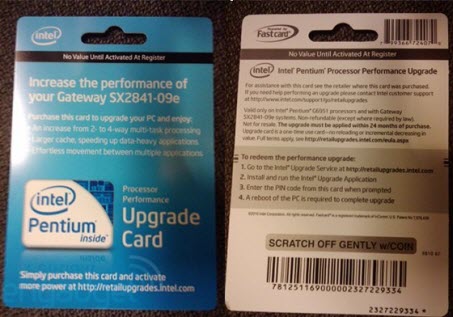Facepalm of the Day: Intel charges customers $50 to unlock CPU features

Sometimes it seems that companies do something so monumentally bone-headed you have to wonder whether anyone is awake at the helm and OKing these crazy moves. Today brings word that chip giant Intel is allowing OEMs to sell CPUs with certain features locked - that the customer can unlock by paying $50 for a software code.
The CPU is a Pentium G6951 and the scheme works like this. OEMs sell suckers consumers a computer featuring a CPU that has some features disabled (in the case of the G6951, 1MB of L3 cache and HyperThreading is disabled). Customers buy a card that contains an unlock code, visit Intel's website, enter the code, download some software, run the software and the locked features are unlocked.
Note: In the case of the G6951, it's upgraded to a G6952, which is roughly equivalent to a Core i3 520.
Intel seems to be marketing the Intel Upgrade Service as a way for system builders and OEMs to increase margins:
System builders: Build upgradable desktop PCs that enable your resellers to upgrade CPU performance down-the-wire.
Resellers: You can configure CPU performance down-the-wire at your point of sale, and increase your margins while doing so.
Intel currently seems to be testing this upgrade mechanism at the budget end of the market in selected markets.
Thanks to an eagle-eyed Engadget reader for spotting the upgrade cards at a Best Buy store:

Now, it's common knowledge that chip makers already tune and de-tune CPUs to create different models in a line-up. CPUs are tested after manufacture and the speed, cache and cores and so on are locked to create the different models depending on the performance and flaws of the individual piece. The process is called binning. Over the years I've seen processors that can have features unlocked on them using a variety of means - for example, via the BIOS, or by careful soldering, or with a pencil line. Then there's the whole overclocking business which revolves around squeezing as much as you can from hardware by taking it way beyond the tolerances that the manufacturer deems acceptable. Silicon nowadays is so reliable that an overclocked part can last just as long as one running at stock speeds as long as a little care is taken.
However, this arbitrary software lock is odd in that Intel is offering to remove it for a fee. Basically it seems processors have become so powerful and so cheap, and the failure rates so low, that the only way that Intel can supply the low end demand is through artificially downgrading chips. Doing that brings with it the opportunity to upgrading the hardware ... for a fee ...
The software world abounds with similar examples. An easy example is Windows, where the features that a user has access to is determined by the key that is used to unlock the software, which is in turn determined by how much the user is willing to pay. Games are another are where this happens, but the practice is rife in the entire software industry.
This seems like a plan by Intel to simplify its CPU lineup and allow some sort of "dial-a-power" mechanism so that a single CPU could be set into a series of different configurations depending on price paid by the consumer and the unlock code entered. Imagine a scenario where Intel could make one CPU, sell that one CPU to OEMs who could them configure it through the use of unlock codes. It would undoubtedly streamline inventories. Sure, it's a trick that can only work at the budget end because not even Intel could afford to ship Core i7s and have them downgraded to cheaper chips. But the budget end is dominated by people who don't really know what they want.
But, despite the upsides, this is still a bone-headed move for Intel to make for a variety of reasons.
- First and foremost, it's more than likely that the upgrade mechanism here is a basic one, and so it won't be long until the process is hacked.
- Secondly, it's highly confusing for the consumer. I really don't see consumers parting with $50 given the description on the upgrade card. People clever enough to know what they want and what the upgrade means aren't buying from Best Buy.
- The flipside is that it is Best Buy we are talking about here as an example. I can see salespeople pressing this on customers, much like warranties pushed. Intel is selling out customers for the sake of $50 ...
- It's a crap upgrade. To be honest, It's not really worth the $50 and customers could spend their money better.
- It makes Intel look cheap. Remember, the features are already packed into all the CPUs, it doesn't matter if they are switched on or not. The cost of adding these features is obviously insignificant, but Intel is still willing to charge people $50 to switch the feature on.
- It's an enormous stick for AMD PR to batter Intel around the head with. Going to such lengths to double-dip customers isn't good PR.
Note: Let's be clear here - I'm not saying this is a scam because users aren't being deceived at any point.
That said, I'm not surprised. In fact, I'm surprised it took this long coming. Much of the hardware business revolved around artificial market segmentation already. The cost different between low-end and high-end hardware is nowhere near the price difference that consumers pay.
Thoughts?